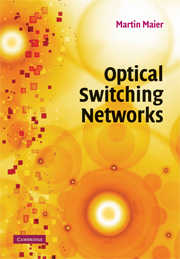Preface
Published online by Cambridge University Press: 10 May 2010
Summary
Optical fiber is commonly recognized as an excellent transmission medium owing to its advantageous properties, such as low attenuation, huge bandwidth, and immunity against electromagnetic interference. Because of their unique properties, optical fibers have been widely deployed to realize high-speed links that may carry either a single wavelength channel or multiple wavelength channels by means of wavelength division multiplexing (WDM). The advent of Erbium doped fiber amplifiers was key to the commercial adoption of WDM links in today's network infrastructure. WDM links offer unprecedented amounts of capacity in a cost-effective manner and are clearly one of the major success stories of optical fiber communications.
Since their initial deployment as high-capacity links, optical WDM fiber links turned out to offer additional benefits apart from high-speed transmission. Most notably, the simple yet very effective concept of optical bypassing enabled network designers to let in-transit traffic remain in the optical domain without undergoing optical-electrical-optical conversion at intermediate network nodes. As a result, intermediate nodes can be optically bypassed and costly optical-electrical-optical conversions can be avoided, which typically represent one of the largest expenditures in optical fiber networks in terms of power consumption, footprint, port count, and processing overhead. More important, optical bypassing gave rise to so-called all-optical networks in which optical signals stay in the optical domain all the way from source node to destination node.
All-optical networks were quickly embraced by both academia and industry, and the research and development of novel architectures, techniques, mechanisms, algorithms, and protocols in the arena of all-optical network design took off immediately worldwide.
- Type
- Chapter
- Information
- Optical Switching Networks , pp. xix - xxPublisher: Cambridge University PressPrint publication year: 2008



